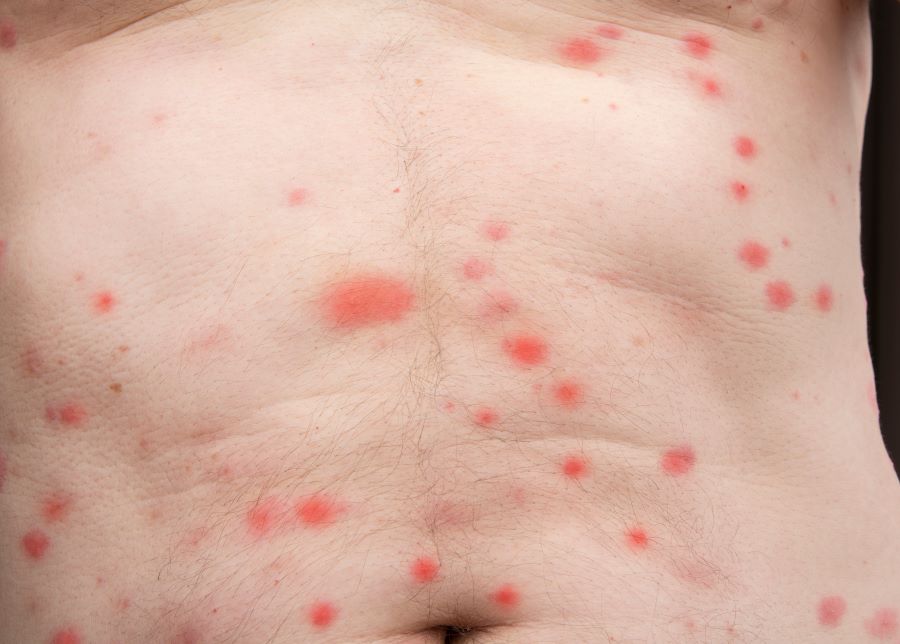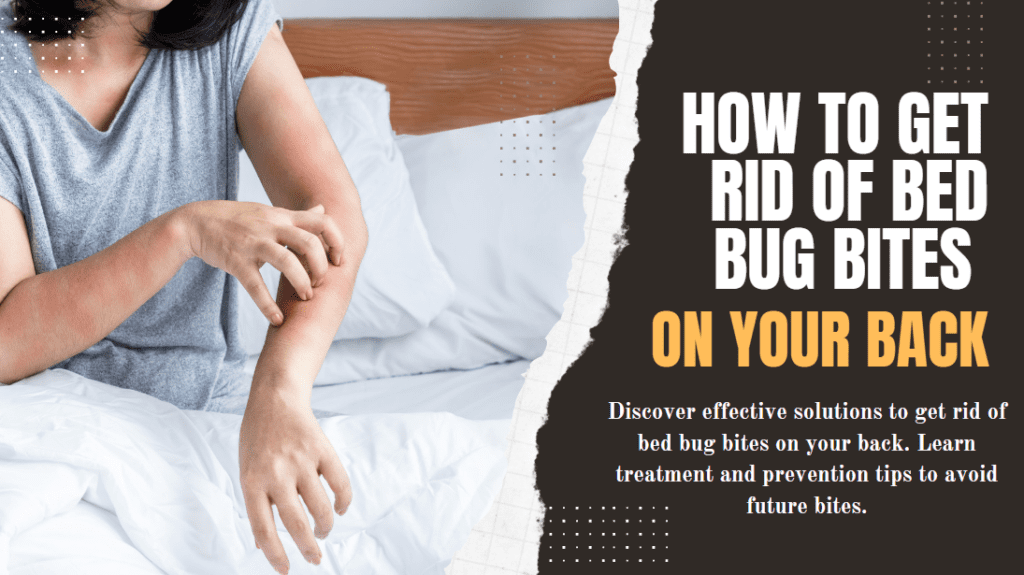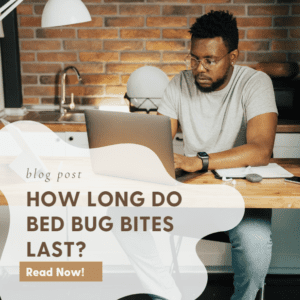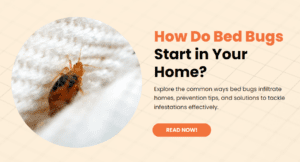Introduction
How to Get Rid of Bed Bug Bites on Your Back. Bed bug bites are a common problem, especially on the back. These pests often target the back because it is exposed and accessible during sleep. Bed bug bites can cause itching, discomfort, and even allergic reactions. Addressing these bites promptly is crucial to prevent complications and ensure quick relief.
The purpose of this article is to provide effective solutions and prevention tips for bed bug bites on your back. We will cover everything from identifying bed bug bites to immediate relief methods, long-term treatments, and preventive measures. By following this comprehensive guide, you can alleviate the discomfort of bed bug bites and protect yourself from future infestations. …Click Here to keep reading about Bed Bugs.
Bed bugs are small, reddish-brown insects that feed on human blood. They are notorious for their ability to hide in cracks and crevices, making them difficult to detect and eliminate. Understanding how to recognize bed bug bites and how to treat them effectively is the first step in managing this persistent problem. According to the Centers for Disease Control and Prevention (CDC), bed bug infestations have been on the rise, making it more important than ever to be vigilant and informed.
In the following sections, we will delve into the specifics of bed bug bites, from immediate relief methods to long-term treatment options and prevention strategies. Our goal is to equip you with the knowledge and tools you need to tackle bed bug bites on your back and maintain a bed bug-free environment. For additional information on bed bugs, you can refer to the Environmental Protection Agency (EPA) for detailed guidance and resources.
Identifying Bed Bug Bites on Your Back
Identifying bed bug bites on your back can be challenging. These bites often resemble other insect bites or skin conditions. However, there are specific characteristics and symptoms that can help you distinguish bed bug bites.

Physical Characteristics of Bed Bug Bites
Bed bug bites usually appear as small, red, itchy bumps. They often occur in clusters or lines, reflecting the bed bug’s feeding pattern. Unlike mosquito bites, bed bug bites tend to be more uniform in size and shape. The bites can become swollen and inflamed, especially if scratched. How to Get Rid of Bed Bug Bites on Your Back.
Symptoms and Signs to Watch For
In addition to the physical appearance of the bites, there are other symptoms to consider. Common signs of bed bug bites include:
– Intense itching, especially at night
– Redness and swelling around the bite area
– Small blisters or hives
– In some cases, allergic reactions may occur, causing severe itching and swelling
Differentiating Bed Bug Bites from Other Insect Bites or Skin Conditions
It is important to differentiate bed bug bites from other insect bites or skin conditions. Here are some tips to help you make the distinction:
- Mosquito Bites: These are usually larger and more irregular in shape compared to bed bug bites.
- Flea Bites: Flea bites are typically found around the ankles and lower legs and often have a central red spot.
- Allergic Reactions: Skin allergies can cause widespread hives or rashes, whereas bed bug bites are usually localized.
By understanding these characteristics and symptoms, you can better identify bed bug bites on your back and take appropriate action. For further details on identifying bed bug bites, refer to the Mayo Clinic, which provides comprehensive information on symptoms and treatment options.
Immediate Relief for Bed Bug Bites on Your Back
When you discover bed bug bites on your back, immediate relief is essential to reduce discomfort and prevent further irritation. Several methods can help alleviate the symptoms quickly and effectively.
Cleaning the Affected Area
The first step in treating bed bug bites is to clean the affected area thoroughly. Use mild soap and lukewarm water to wash the bites. This helps remove any dirt or bacteria that could cause infection. Pat the area dry with a clean towel, avoiding any harsh rubbing that could aggravate the bites.
Over-the-Counter Treatments and Home Remedies
Several over-the-counter treatments and home remedies can provide quick relief from bed bug bites. These options are easily accessible and can significantly reduce itching and inflammation. How to Get Rid of Bed Bug Bites on Your Back.
Calamine Lotion and Hydrocortisone Cream
Calamine lotion and hydrocortisone cream are effective in reducing itching and swelling. Apply a thin layer of either treatment to the bites several times a day. These products can help soothe the skin and promote healing.
Antihistamines
Oral antihistamines, such as diphenhydramine (Benadryl), can help alleviate severe itching and allergic reactions. Follow the dosage instructions on the package or consult a healthcare professional for advice.
Natural Remedies
Natural remedies can also provide relief from bed bug bites. Here are a few popular options:
- Aloe Vera: Aloe vera gel has anti-inflammatory properties that can soothe irritated skin. Apply the gel directly to the bites for relief.
- Tea Tree Oil: Dilute tea tree oil with a carrier oil, such as coconut oil, and apply it to the bites. Tea tree oil has antiseptic properties that can help prevent infection.
- Oatmeal Baths: An oatmeal bath can reduce itching and inflammation. Add a cup of finely ground oatmeal to a warm bath and soak for 15-20 minutes.
When to Seek Medical Attention
While most bed bug bites can be treated at home, some cases may require medical attention. Seek help from a healthcare professional if you experience any of the following:
– Severe allergic reactions, such as difficulty breathing or swelling of the face and throat
– Signs of infection, such as increased redness, warmth, pus, or fever
– Persistent or worsening symptoms despite home treatment
By following these immediate relief methods, you can effectively manage the discomfort of bed bug bites on your back and prevent complications. For more detailed information on treating insect bites, the American Academy of Dermatology offers valuable resources and expert advice.
Long-Term Treatment Options
For persistent or severe bed bug bites on your back, long-term treatment options may be necessary. These treatments help manage symptoms, promote healing, and prevent complications.
Prescription Medications for Severe Reactions
If over-the-counter treatments are not effective, prescription medications may be required. A doctor can prescribe stronger antihistamines, corticosteroids, or antibiotics to address severe allergic reactions or infections. These medications can help reduce inflammation, control itching, and prevent secondary infections.
Professional Treatments: Dermatologists and Allergists
Visiting a dermatologist or allergist can provide specialized care for severe or persistent bed bug bites. Dermatologists can offer treatments like topical or oral steroids to reduce inflammation and itching. They can also provide guidance on skin care to promote healing. Allergists can help manage allergic reactions and provide allergy testing to determine if you are particularly sensitive to bed bug bites.
Healing Time and Care for the Skin
The healing time for bed bug bites varies depending on the severity of the reaction and the effectiveness of the treatment. Typically, bed bug bites heal within one to two weeks. However, severe bites may take longer to heal. During the healing process, it is important to care for your skin properly:
- Avoid Scratching: Scratching can lead to skin infections and prolong the healing process. Keep your nails trimmed and consider wearing gloves at night to prevent scratching.
- Moisturize the Skin: Use a gentle, fragrance-free moisturizer to keep the skin hydrated and promote healing.
- Avoid Irritants: Steer clear of harsh soaps, hot water, and other skin irritants that can exacerbate symptoms.
By following these long-term treatment options, you can effectively manage and heal bed bug bites on your back. For more information on managing skin reactions, refer to the American Academy of Allergy, Asthma & Immunology (AAAAI), which provides comprehensive resources and expert advice.
Preventing Bed Bug Bites on Your Back
Preventing bed bug bites on your back involves maintaining a clean and bed bug-free environment. Implementing preventive measures can help you avoid future infestations and protect your skin from these irritating bites.
Inspecting and Cleaning Your Sleeping Area
Regularly inspecting and cleaning your sleeping area is crucial in preventing bed bug bites. Follow these steps to keep your bed bug-free:
- Inspect Mattress and Bedding: Regularly check your mattress, box spring, and bedding for signs of bed bugs. Look for small rust-colored stains, shed skins, or live bugs.
- Clean Bedding Weekly: Wash your sheets, pillowcases, and blankets in hot water (at least 120°F) and dry them on high heat. This kills any bed bugs and their eggs.
- Vacuum Regularly: Vacuum your mattress, bed frame, and surrounding areas frequently. Use a vacuum with a HEPA filter to capture bed bugs and their eggs.
Using Bed Bug-Proof Mattress Encasements
Bed bug-proof mattress encasements can prevent bed bugs from infesting your mattress and box spring. These encasements are designed to trap bed bugs inside and keep them from biting you. Choose encasements that are labeled as “bed bug-proof” and ensure they cover your entire mattress and box spring.
Keeping Clutter to a Minimum
Clutter provides hiding places for bed bugs, making it harder to eliminate them. Keep your bedroom tidy and free of unnecessary items. Store belongings in sealed plastic containers to prevent bed bugs from accessing them.
Regularly Washing and Drying Bedding on High Heat
High heat is an effective way to kill bed bugs and their eggs. Wash your bedding in hot water and dry it on the highest heat setting. This practice should be part of your regular cleaning routine to ensure any potential bed bugs are eliminated.
By following these preventive measures, you can significantly reduce the risk of bed bug bites on your back. For additional tips on preventing bed bug infestations, the Centers for Disease Control and Prevention (CDC) offers valuable resources and guidelines.
Dealing with Bed Bug Infestations
If you suspect a bed bug infestation, it’s crucial to address it promptly to prevent bites and further spread. Understanding the signs of an infestation and knowing effective removal methods can help you tackle this issue effectively.
Signs of a Bed Bug Infestation
Recognizing the signs of a bed bug infestation is the first step in dealing with it. Here are common indicators:
- Bite Marks: Clusters or lines of red, itchy bites, often on the back.
- Rust-Colored Stains: These are bed bug excrement and can be found on sheets, mattresses, or walls.
- Shed Skins: Bed bugs shed their skins as they grow, leaving behind these telltale signs.
- Live Bed Bugs: Adult bed bugs are small, flat, and reddish-brown. They can be seen with the naked eye, especially in mattress seams and cracks in the bed frame.
DIY Bed Bug Removal Methods
There are several do-it-yourself methods to address bed bug infestations. These methods can be effective if the infestation is caught early.
Vacuuming
Vacuuming can help remove bed bugs and their eggs from your mattress, bed frame, and surrounding areas. Use a vacuum with a HEPA filter and dispose of the vacuum bag immediately after use.
Steam Cleaning
Steam cleaning is a highly effective method for killing bed bugs and their eggs. The high temperature of the steam penetrates deep into fabrics and crevices, where bed bugs often hide. Make sure to steam clean your mattress, bed frame, and any upholstered furniture in the infested area.
Diatomaceous Earth
Diatomaceous earth is a natural, non-toxic powder that can kill bed bugs by dehydrating them. Sprinkle a thin layer of diatomaceous earth around the perimeter of the infested area and in any cracks or crevices where bed bugs might hide. Leave it for several days before vacuuming it up.
When to Call a Professional Exterminator
In some cases, a bed bug infestation may be too severe for DIY methods. If you notice persistent signs of bed bugs despite your efforts, it’s time to call a professional exterminator. Professional pest control services have access to more powerful treatments and can ensure that all bed bugs are eradicated. They can also provide ongoing monitoring to prevent future infestations.
By recognizing the signs of a bed bug infestation and using effective removal methods, you can address the problem quickly and efficiently. For more detailed guidance on handling bed bug infestations, the Environmental Protection Agency (EPA) provides comprehensive resources and recommendations.
Bed Bug Prevention Tips
Preventing bed bug bites and infestations involves taking proactive measures both at home and when traveling. Implementing these strategies can help you avoid the discomfort and inconvenience of dealing with bed bugs.
Tips for Traveling and Staying in Hotels
Bed bugs can easily hitch a ride on your luggage and clothing when you travel. Follow these tips to protect yourself while away from home:
Inspect Hotel Rooms
Before settling into your hotel room, inspect the bed and surrounding areas for signs of bed bugs. Check the mattress seams, headboard, and bedside furniture for rust-colored stains, shed skins, or live bugs.
Keep Luggage Off the Floor
Use luggage racks to keep your suitcases off the floor and away from the bed. Avoid placing your belongings on upholstered furniture or carpeted areas where bed bugs can hide.
Store Clothes in Sealed Bags
Keep your clothes in sealed plastic bags inside your suitcase to prevent bed bugs from accessing them. This also makes it easier to transport your belongings without bringing bed bugs home.
Wash Clothes Immediately After Travel
When you return home, wash all your clothes in hot water and dry them on high heat. This kills any bed bugs that may have hitched a ride. Also, vacuum your luggage thoroughly to remove any remaining bugs.
Preventative Measures for Your Home
Keeping your home bed bug-free requires regular maintenance and vigilance. Here are some effective preventive measures:
Regular Inspections
Conduct regular inspections of your mattress, box spring, and furniture for signs of bed bugs. Early detection can help prevent a full-blown infestation.
Seal Cracks and Crevices
Bed bugs can hide in small cracks and crevices in walls, floors, and furniture. Seal these entry points with caulk or another suitable sealant to reduce hiding spots.
Reduce Clutter
Clutter provides hiding places for bed bugs, making it difficult to detect and eliminate them. Keep your living spaces tidy and free of unnecessary items.
Use Bed Bug Interceptors
Place bed bug interceptors under the legs of your bed and furniture. These devices trap bed bugs as they attempt to climb up, preventing them from reaching you while you sleep.
Educating Family and Friends About Bed Bug Prevention
Educating those around you about bed bug prevention is crucial to maintaining a bed bug-free environment. Share these tips with family and friends to help them protect their homes and prevent the spread of bed bugs:
- Discuss Travel Precautions: Inform them about the importance of inspecting hotel rooms and taking preventive measures when traveling.
- Promote Regular Inspections: Encourage regular home inspections for early detection and prevention.
- Share Resources: Provide them with links to reputable sources, such as the Centers for Disease Control and Prevention (CDC), for more information on preventing bed bug infestations.
By following these bed bug prevention tips, you can reduce the risk of bed bug bites and infestations in your home and while traveling. Staying informed and proactive is key to maintaining a bed bug-free environment.
Conclusion
Bed bug bites on your back can cause significant discomfort, but with prompt and effective treatment, you can alleviate the symptoms and prevent further issues. This comprehensive guide has provided you with the tools to identify bed bug bites, implement immediate relief methods, explore long-term treatments, and adopt preventive measures to avoid future infestations.
Recap of Key Points
- Identifying Bed Bug Bites: Recognize the physical characteristics, symptoms, and differentiate them from other skin conditions.
- Immediate Relief: Clean the affected area, use over-the-counter treatments and home remedies, and seek medical attention when necessary.
- Long-Term Treatments: Consider prescription medications, professional treatments, and proper skin care.
- Preventing Bites: Regularly inspect and clean your sleeping area, use bed bug-proof encasements, wash and dry bedding on high heat, and minimize clutter.
- Dealing with Infestations: Recognize signs of an infestation, use DIY removal methods, and know when to call a professional exterminator.
- Prevention Tips: Follow travel precautions, maintain a clean home, and educate family and friends about bed bug prevention.
Encouragement to Take Immediate Action
Taking immediate action is crucial for effective relief and prevention. Begin by inspecting your sleeping area and treating any bites promptly. Implement the preventive measures discussed to maintain a bed bug-free environment. Remember, early detection and intervention are key to managing bed bug issues.
Final Thoughts on Maintaining a Bed Bug-Free Environment
Maintaining a bed bug-free environment requires vigilance and regular maintenance. By staying informed and proactive, you can protect yourself and your home from these persistent pests. Share this knowledge with others to help prevent the spread of bed bugs and ensure a comfortable living space for everyone.
Additional Resources
For more information and expert advice on bed bug prevention and treatment, consider exploring the following resources:
- Centers for Disease Control and Prevention (CDC): Comprehensive guidelines on preventing and dealing with bed bugs.
- Environmental Protection Agency (EPA): Detailed information on bed bug control and treatment options.
- American Academy of Dermatology (AAD): Expert advice on treating bed bug bites and skin care.
By utilizing these resources and following the guidance provided in this article, you can effectively manage and prevent bed bug bites on your back, ensuring a comfortable and healthy living environment.




